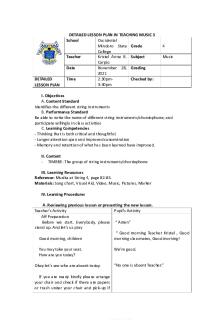Lesson plan 3 Monday[ 9821] PDF
![Lesson plan 3 Monday[ 9821]](https://pdfedu.com/img/crop/300x450/1o20o0vd72n0.jpg)
| Title | Lesson plan 3 Monday[ 9821] |
|---|---|
| Author | Thao Tran |
| Course | General Chemistry |
| Institution | University of California Irvine |
| Pages | 5 |
| File Size | 97.3 KB |
| File Type | |
| Total Downloads | 10 |
| Total Views | 133 |
Summary
Download Lesson plan 3 Monday[ 9821] PDF
Description
CHEM 1A - Week 3 Monday (October 14, 2019) Lesson Plan for Professor Arasasingham with LARC Leader: Shania Day
LEARNING GOAL: Students will be able to solve Electromagnetic Radiation problems and problems about the Wave Nature of Matter by working in groups to find the answers while getting familiar with using their scientific calculators.
ICEBREAKER: 1. Take about 5 minutes to find 2 things each of you have in common with each other in your table groups. Once the 5 minutes are up you will present each other to the class.
Guided Practice: 1.
1
Behavior of Waves
Electromagnetic Radiation
Wave - Particle Duality of Electromagnetic Radiation
1. Reflection: change in direction of wave when it bounces off a barrier and goes in a new direction within the same medium
1. Energy that travels through electromagnetic waves and empty space 2. Does not require a medium for transmission like air or water
Theory that electromagnetic radiation has wave and particle-like properties 1. Means that light can also exhibit
2. Refraction: change in direction of wave as it passes into and through a new medium 3. Diffraction: bending of the wave around a corner of a barrier or through holes in the barrier 4. Interference: Constructive Interference when 2 waves are in phase and have the same properties making them additive Vs. Destructive Interference when 2 waves are out of phase and their properties are offset making them not additive
2
3. Has both electric and magnetic field Speed of transport energy/ speed of light constant (c) = 3.00 x 10^8 m/s Speed of electromagnetic wave = c = ν ( λ) in m/s
properties of waves or particles but never both at the same time Wave-particle Duality Equation: m = h/ λc M = mass in kg h= planck’s constant (6.626 x 10^-34 in J.s) λ in meters C = in speed of light in m/s De Brogile Equation: m = h/ λu U = speed of the particle or a=object in m/s When mass is large, wavelength is small (inverse) Energy (E) is proportional to frequency: E = hν Making Etotal = n or Na h ν Where n is the number of quanta/ packets being transferred 1 photon = 1 quanta Na is avogrado’s number E photon = h (c/λ)
2. Explain Black Body Radiation in terms of what it measures and the relationship that can be seen between temperature and wavelength.
Group Practice: 1. Calculate the wavelength of each frequency of electromagnetic radiation: a. 100.2 MHz (typical frequency for FM radio broadcasting) b. 1070 kHz (typical frequency for AM radio broadcasting) (assume four significant figures) c. 835.6 MHz (common frequency used for cell phone communication) 2. Calculate the energy of a photon of electromagnetic radiation at each of the frequencies indicated in the question above A. B.
3
C. 3. A heat lamp produces 32.8 watts of power at a wavelength of 6.5 um. How many photons are emitted per second? (1 watt = 1 J/s)
Independent Practice: 1. How much energy is contained in 1 mol of each? a. X-ray photons with a wavelength of 0.135 nm b. g-ray photons with a wavelength of 2.15 * 10-5 nm 2. The smallest atoms can themselves exhibit quantum-mechanical behavior. Calculate the de Broglie wavelength (in pm) of a hydrogen atom traveling 475 m/s. 3. A proton in a linear accelerator has a de Broglie wavelength of 122 pm. What is 4
the speed of the proton?
ACTIVITY Write down any questions you still have and post them to the discussion board on canvas to allow fellow students to answer them.
5 ...
Similar Free PDFs
![Lesson plan 3 Monday[ 9821]](https://pdfedu.com/img/crop/172x258/1o20o0vd72n0.jpg)
Lesson plan 3 Monday[ 9821]
- 5 Pages

Lesson plan for Monday October 7
- 3 Pages

Lesson Plan 3- Edtpa
- 4 Pages

Lesson plan in Music 3
- 9 Pages

Lesson Plan
- 8 Pages

Lesson plan
- 5 Pages

Group 3 - EDC 400 Final Lesson PLAN
- 38 Pages
Popular Institutions
- Tinajero National High School - Annex
- Politeknik Caltex Riau
- Yokohama City University
- SGT University
- University of Al-Qadisiyah
- Divine Word College of Vigan
- Techniek College Rotterdam
- Universidade de Santiago
- Universiti Teknologi MARA Cawangan Johor Kampus Pasir Gudang
- Poltekkes Kemenkes Yogyakarta
- Baguio City National High School
- Colegio san marcos
- preparatoria uno
- Centro de Bachillerato Tecnológico Industrial y de Servicios No. 107
- Dalian Maritime University
- Quang Trung Secondary School
- Colegio Tecnológico en Informática
- Corporación Regional de Educación Superior
- Grupo CEDVA
- Dar Al Uloom University
- Centro de Estudios Preuniversitarios de la Universidad Nacional de Ingeniería
- 上智大学
- Aakash International School, Nuna Majara
- San Felipe Neri Catholic School
- Kang Chiao International School - New Taipei City
- Misamis Occidental National High School
- Institución Educativa Escuela Normal Juan Ladrilleros
- Kolehiyo ng Pantukan
- Batanes State College
- Instituto Continental
- Sekolah Menengah Kejuruan Kesehatan Kaltara (Tarakan)
- Colegio de La Inmaculada Concepcion - Cebu








